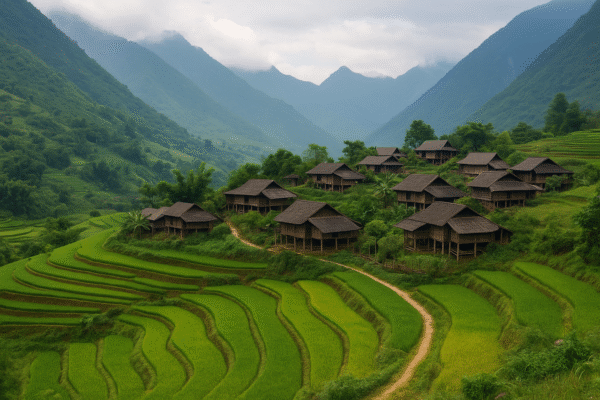Amid Asia’s growing mountain tourism scene, Ta Van village, a peaceful enclave in Vietnam’s Lào Cai Province, is gaining international recognition as one of the most beautiful and tranquil destinations in the region. Surrounded by the verdant Hoàng Liên Son mountain range and just 12 kilometers from the busy tourist hub of Sa Pa, Ta Van offers a serene alternative for travelers in search of scenic beauty and cultural authenticity.
This accolade, recently highlighted by the South China Morning Post, places Ta Van among elite Asian retreats like Shirakawa in Japan, Ella in Sri Lanka, and Hundar in India’s Ladakh region. These destinations are united not just by breathtaking natural settings but also by their commitment to preserving tradition, culture, and environmental sustainability.
Ta Van: Vietnam’s Undiscovered Gem in Sa Pa
Tucked deep in the Muong Hoa Valley, Ta Van village is home to the Giay and Hmong ethnic minorities, known for their traditional stilt houses, handwoven textiles, and warm hospitality. Unlike the crowded Cat Cat village, Ta Van remains a peaceful refuge where visitors can genuinely connect with local culture and lifestyle.
Surrounded by layered rice terraces, winding bamboo trails, and cascading waterfalls, Ta Van is a favorite among eco-conscious travelers, trekkers, and photographers. With trails that stretch from Sa Pa to Giang Ta Chai, visitors are rewarded with views of unspoiled nature and traditional village life.
Accommodation ranges from rustic homestays to boutique eco-lodges, offering meals made with organic ingredients sourced from local farms. Many of these stays allow guests to participate in daily activities like rice planting, dyeing fabrics with indigo, or sharing traditional meals by the fire.
Why Ta Van Stands Out Among Asia’s Mountain Villages
While many Asian destinations attract tourists with dramatic scenery, few match the raw authenticity of Ta Van. According to Vietnam’s General Statistics Office, domestic and international travel to rural areas like Sa Pa is rising due to growing interest in slow travel and cultural immersion.
Here’s why Ta Van ranks among the continent’s top hidden mountain villages:
- Sustainable Tourism: The community has partnered with conservation programs and NGOs to manage tourism sustainably. Infrastructure upgrades include eco-toilets and guided nature treks that protect the land and educate visitors.
- Cultural Preservation: Local traditions, language, and crafts are preserved and proudly shared. Festivals and ceremonies often welcome guests with music, dance, and home-cooked delicacies.
- Scenic Diversity: Visitors can traverse terraced rice paddies, cross hanging bridges, explore bamboo forests, and relax by waterfalls—all within a few kilometers.
- Affordability: Unlike more commercialized destinations, travel in Ta Van remains budget-friendly. Motorbike rentals cost about US$8–12 per day, and homestays average US$10–25 per night with meals included.
Comparing Asia’s Top Scenic Villages
While Ta Van shines, it shares company with other hidden jewels across Asia:
- Hundar, Ladakh (India): Set against sand dunes and Himalayan peaks, this desert village combines Buddhist culture with breathtaking terrain.
- Shirakawa, Japan: With UNESCO-listed gassho-zukuri farmhouses, this snowy retreat draws architecture lovers and solitude seekers.
- Ella, Sri Lanka: A highland village surrounded by tea plantations, offering sweeping views and cool breezes.
- Wuyi Mountain Villages, China: Places like Huangling in Jiangxi Province burst with color during harvest, offering a glimpse into China’s agrarian history.
- Mae Kampong, Thailand: Located near Chiang Mai, this village thrives on coffee, tea farming, and sustainable ecotourism.
Each of these locations shares a commitment to slow living and heritage preservation, making them ideal for travelers eager to unplug and reconnect with nature and culture.
How to Get to Ta Van and Travel Tips
To reach Ta Van:
- Travel to Sa Pa from Hanoi by overnight train or limousine bus (approx. 5–6 hours).
- From Sa Pa town, take a local taxi or rent a motorbike to reach Ta Van (12 km).
- Trekking tours with local guides are also available and recommended for first-time visitors.
Travel Tips:
- Best time to visit: March to May or September to November (for golden rice terraces).
- Pack light layers for chilly mornings and rain gear during monsoon months (June–August).
- Support local artisans by buying handwoven textiles, herbal balms, or handmade jewelry.
A Peaceful Future for Vietnam’s Rural Tourism
Vietnam’s Ministry of Culture, Sports and Tourism has been pushing for the growth of community-based tourism in ethnic regions like Lào Cai. According to the Vietnam National Administration of Tourism (VNAT), destinations such as Ta Van align with government goals to promote rural tourism while preserving ethnic culture and limiting environmental harm.
Efforts are underway to introduce better waste management systems, eco-education programs for villagers, and enhanced trail signage for safer treks. With its scenic allure and cultural integrity, Ta Van could very well become a model for sustainable tourism in Vietnam and beyond.
Conclusion
For those craving a more peaceful, culturally rich travel experience in Asia, Ta Van village offers the perfect blend of natural splendor, authentic hospitality, and eco-conscious living. As more travelers seek deeper meaning in their journeys, this hidden mountain retreat stands ready to welcome those in search of serenity and connection—without the crowds.
For more travel news like this, keep reading Global Travel Wire



















